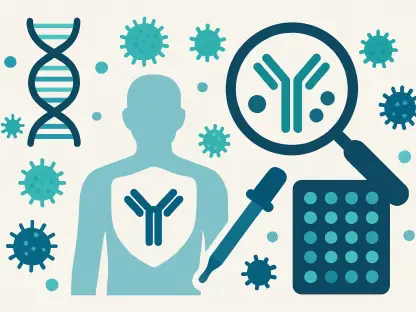In the rapidly evolving realm of advanced therapy medicinal products (ATMPs) and complex biologics, the promise of transforming patient care is both exhilarating and daunting, as these cutting-edge treatments hold the potential to address some of the most pressing unmet medical needs, from rare genetic disorders to aggressive cancers. Yet, the journey from lab to market is riddled with intricate regulatory challenges that test even the most seasoned developers. Striking a balance between the urgent need to deliver therapies swiftly and the non-negotiable demand for stringent safety and quality standards remains a formidable task. This article delves into actionable strategies and expert insights to illuminate how developers can accelerate the path to approval for advanced therapies while upholding the rigorous benchmarks set by global regulatory bodies.
The stakes in this field are exceptionally high. With patients awaiting life-changing treatments, the pressure to expedite development is immense. However, regulatory agencies like the FDA and EMA maintain an unwavering focus on evidence of safety, efficacy, and consistency. Navigating this landscape requires not only scientific innovation but also a deep understanding of regulatory expectations. Developers must anticipate hurdles early and adopt proactive measures to ensure compliance without sacrificing speed, setting the stage for a nuanced exploration of this critical balance.
Navigating Regulatory Challenges
Tackling Manufacturing Complexities
The inherent intricacies of advanced therapies often surface in the realm of Chemistry, Manufacturing, and Controls (CMC), where maintaining consistency across production batches poses a significant obstacle. Unlike conventional pharmaceuticals, ATMPs rely on biological materials that naturally vary, complicating efforts to scale manufacturing while adhering to strict regulatory standards. A pivotal aspect lies in establishing a potency Critical Quality Attribute (CQA), which serves as a measurable indicator of the therapy’s intended therapeutic effect. Without a well-defined potency CQA, ensuring uniform performance across batches becomes nearly impossible, risking regulatory rejection. Developers must invest in robust testing frameworks to validate these attributes early in the process, laying a foundation for consistent quality that meets agency expectations.
Comparability is another cornerstone in overcoming manufacturing challenges for advanced therapies. As production processes evolve—whether due to scaling up or adapting to new technologies—demonstrating that safety, efficacy, and quality remain unchanged is essential. Regulatory bodies scrutinize any modifications, demanding clear evidence that alterations do not compromise the therapy’s profile. This often involves retaining early-phase samples for later comparison and designing detailed analytical methods to track stability. Such meticulous documentation not only supports compliance but also builds a compelling case during regulatory reviews. By prioritizing comparability, developers can mitigate the risk of delays and foster confidence in their manufacturing strategies, ensuring that innovation does not outpace reliability.
Addressing Biological Variability
Biological variability in advanced therapies introduces a unique set of hurdles that can confound even the most advanced development teams. The raw materials, often derived from living cells or tissues, are subject to natural fluctuations that can affect the final product’s consistency. Regulatory agencies expect developers to account for this variability through rigorous characterization and control measures, ensuring that each batch delivers the same therapeutic benefit. This requires sophisticated analytical tools and a deep understanding of the biological mechanisms at play, as even minor deviations can have significant downstream impacts on patient outcomes. Tackling this issue head-on is critical to gaining approval and maintaining trust in these innovative treatments.
Beyond characterization, developers must also navigate the regulatory emphasis on long-term data to address variability concerns. Agencies often request extended stability studies and real-world evidence to confirm that therapies remain effective over time despite biological differences. This can be particularly challenging for smaller firms with limited resources, as gathering such data demands substantial investment in infrastructure and expertise. Strategic planning becomes indispensable, with a focus on designing studies that anticipate these requirements from the outset. By embedding variability considerations into early development phases, companies can avoid costly redesigns and accelerate their path to market while satisfying the stringent demands of global regulators.
Strategies for Global Success
Aligning with Multi-Region Standards
The globalization of drug development amplifies the complexity of bringing advanced therapies to market, as regulatory requirements diverge significantly across regions and even within continents. For instance, the criteria for orphan drug designations can vary between the FDA and EMA, creating potential misalignments in development plans. In Europe, the introduction of the Joint Clinical Assessment (JCA) under new health technology assessment regulations adds further layers of scrutiny, particularly for ATMPs and oncology products. Developers must adopt a forward-thinking approach, mapping out these differences early to design clinical trials and manufacturing processes that are adaptable to multiple jurisdictions. Leveraging joint scientific consultations with regulatory and health technology bodies can streamline this alignment, reducing the risk of redundant efforts or trial redesigns.
Navigating these regional disparities also demands a comprehensive understanding of local priorities and timelines. Some markets may prioritize rapid access to innovative therapies, while others emphasize exhaustive safety data before granting approval. This patchwork of expectations necessitates a tailored strategy that anticipates specific regional needs without compromising the core integrity of the therapy’s development. Engaging with local regulatory authorities through structured dialogues—such as pre-submission meetings—can provide critical insights into these nuances. By integrating multi-region planning into the earliest stages of development, companies can enhance their agility, ensuring that their therapies are positioned for success across diverse global landscapes without facing unexpected regulatory roadblocks.
Harnessing External Expertise
For smaller biotech firms, the labyrinth of regulatory requirements can seem insurmountable, often straining limited internal resources and expertise. Partnering with seasoned consultants offers a strategic advantage, providing access to specialized knowledge in navigating complex approval processes. These experts assist in crafting precise documentation, framing critical questions for regulatory interactions, and preparing for high-stakes meetings with agencies. Their guidance is particularly valuable when pursuing special designations like RMAT in the US or PRIME in Europe, where a nuanced understanding of criteria can make or break an application. Such collaborations empower smaller entities to compete on a level playing field, enhancing their capacity to meet stringent standards without diverting focus from core scientific innovation.
External expertise also plays a pivotal role in designing long-term follow-up studies, which are often mandated for advanced therapies to monitor safety and efficacy post-approval. Consultants bring insights from past engagements, helping to structure these studies in ways that satisfy regulatory expectations while optimizing resource allocation. Their involvement extends to building robust comparability narratives, ensuring that manufacturing changes are well-documented and defensible during agency reviews. This support not only mitigates the risk of regulatory setbacks but also instills confidence in smaller firms as they tackle the multifaceted demands of global markets. By leveraging such partnerships, developers can focus on advancing their therapeutic breakthroughs while resting assured that compliance remains a top priority.
Harnessing Expedited Pathways
Prioritizing Data Over Haste
Expedited regulatory pathways have emerged as powerful tools for reducing the time-to-market for advanced therapies, offering significant advantages in addressing urgent patient needs. Mechanisms like the FDA’s Priority Review, Breakthrough Therapy, and Fast Track, alongside the EMA’s PRIME designation, have been widely adopted, with recent figures indicating that 79% of US product launches in the prior year utilized at least one such pathway. These programs can shave years off traditional timelines, accelerating access to life-changing treatments. However, the allure of speed must be tempered by a commitment to data integrity. Regulatory bodies remain steadfast in their demand for comprehensive evidence of safety, efficacy, and durability, and any shortfall in these areas can nullify the benefits of fast-track status, leading to delays or outright rejections.
The emphasis on data quality over speed underscores a critical lesson for developers navigating these pathways. Rushing through clinical phases without sufficient evidence risks undermining the therapy’s credibility, potentially eroding patient and agency trust. A balanced approach involves aligning expedited submissions with robust study designs that prioritize long-term outcomes alongside immediate results. This means investing in thorough preclinical and early-phase data collection to build a strong foundation for later stages. By maintaining this focus, developers can harness the full potential of accelerated mechanisms without compromising the fundamental principles of regulatory compliance, ensuring that therapies not only reach the market faster but also stand the test of scrutiny over time.
Implementing Actionable Fast-Track Measures
Practical strategies are essential for maximizing the benefits of expedited pathways while upholding regulatory rigor in the development of advanced therapies. One key measure involves retaining samples from Phase I trials for future batch comparisons, providing a baseline to demonstrate consistency as manufacturing evolves. Additionally, designing quantitative and stability-indicating potency assays early in the process helps validate the therapy’s performance across different production runs. These steps, though resource-intensive, are critical for building a compelling case during regulatory reviews, minimizing the likelihood of delays due to insufficient data. Such meticulous preparation ensures that speed aligns with substance, reinforcing the therapy’s value proposition.
Another actionable approach lies in crafting a clear comparability narrative that documents manufacturing changes and their impact on the therapy’s profile. This narrative serves as a vital tool in regulatory submissions, offering transparency and evidence that safety and efficacy remain unaffected by process adaptations. Industry insights suggest that integrating these practices into a broader development framework—rather than treating them as afterthoughts—can significantly enhance approval prospects. Developers are also encouraged to seek feedback from regulatory agencies during early interactions to refine these strategies, ensuring alignment with expectations. By embedding such measures into their workflows, companies can navigate fast-track pathways with confidence, delivering therapies to patients swiftly without sacrificing the quality or credibility demanded by global standards.
Reflecting on Milestones Achieved
Looking back, the journey of advancing therapies through regulatory landscapes reveals a profound synergy between innovation and compliance. Developers grappled with the complexities of biological variability and manufacturing challenges, yet many successfully navigated these obstacles by embracing early planning and strategic engagement with regulatory bodies. The adoption of expedited pathways proved transformative, enabling swifter access to critical treatments while maintaining a steadfast commitment to data quality. Collaborations with expert consultants empowered smaller firms to overcome resource constraints, ensuring that even the most ambitious projects met rigorous global standards. These milestones underscore the importance of foresight and adaptability in achieving regulatory success. Moving forward, the focus should shift to refining these strategies, anticipating evolving frameworks, and fostering deeper partnerships with agencies to sustain momentum. By building on past achievements, the industry can continue to deliver groundbreaking therapies that transform lives with both speed and integrity.









